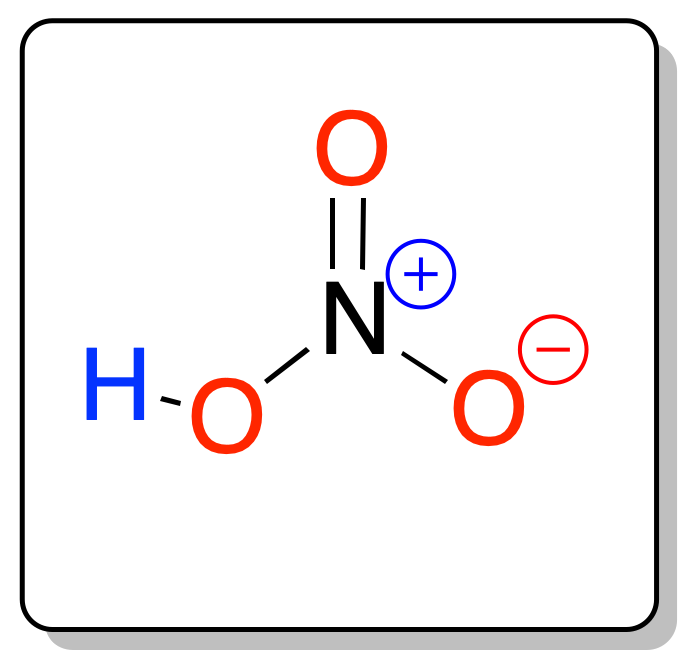Written by J.A Dobado | Last Updated on April 22, 2024
What is nitric acid?
It is a mineral acid of general formula HNO3, which is also known as fuming acid.
 |
| 3D Structure |
Physico-chemical properties
Nitric acid HNO3, is a viscous, odorless, colorless liquid, in pure form, but brownish yellow in color, due to dissolved nitrogen oxide impurities. It releases yellow fumes (hence its name fuming acid) at room temperature. It is soluble in water and has a melting point of -41.6 ºC, and a boiling point of 83 ºC.
Acid-base properties
It is a strong acid and also a good oxidizing agent, and its reactions with carbide or cyanide groups can be explosive. Because it is a monoprotic strong acid, in aqueous solution it dissociates as follows:
HNO3 + H2O → NO3⊖ + H3O⊕
In addition to its acidic character, HNO3 reacts with most bases to give the corresponding nitrate. The resulting NO3⊖ nitrate ions form the salts of nitric acid, and are called by the same name (nitrates). For example, silver nitrate (AgNOsub>3).
Likewise, because it is a strong mineral acid, it has the ability to displace other weaker acids. For example, it displaces the salt of acetic acid (sodium acetate) when it reacts as follows to form sodium nitrate:
HNO3 + CH3COONa → NaNO3 + CH3COOH
Similarly, the reaction of sulfuric acid with potassium nitrate produces nitric acid and a precipitate of potassium bisulfate.
It is also particularly useful in organic electrophilic aromatic substitution reactions (SEAr), due to the reaction that takes place with sulfuric acid to give the nitronium ion (NO⊕2).
It is thermally unstable, and upon heating it decomposes as follows:
4HNO3 → 4NO2 ↑ + 2H2O + O2↑
In addition, the 1:3 (molar ratio) mixture of nitric acid and hydrochloric acid is called aqua regia. The name comes from alchemy because this solution dissolved noble metals such as gold and platinum.
Production
Nitric acid is obtained by mixing dinitrogen pentoxide (N2O5) and water giving pure HNO3.
N2O5 + H2O → HNO3
However, distillation must be carried out with H2SO4, since HNO3 forms an azeotrope with water (68 % of HNO3 and 32 % of H2O).
Because of this, it is distributed in commercial solutions with concentrations in the range 52-68 % of nitric acid. Furthermore, when this value is higher than 86 %, it is called fuming nitric acid (in two varieties: white and red). White fuming HNO3 is also labeled as 100 %, because the water content is less than 1 %.
Ostwald process
At the industrial level, it is produced by the Ostwald process, through the reaction of ammonia with oxygen in the air, and catalyzed by platinum at high temperatures (1000 ºC).
4NH3 + 5O2 → 4NO↑ + 6H2O
The nitrogen oxide gas NO passes into metal absorption towers to give the following reaction:
2NO + O2 → 2NO2↑
Subsequently, the nitrogen dioxide formed reacts with water:
3NO2 + H2O → 2HNO3 + NO↑
Finally, nitrous oxide reacts again with oxygen as follows:
2NO + O2 → 2NO2↑